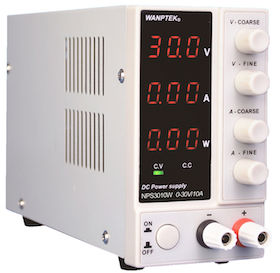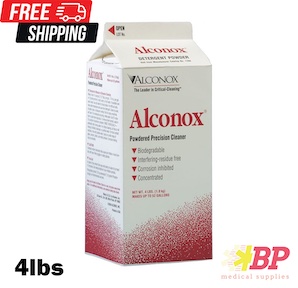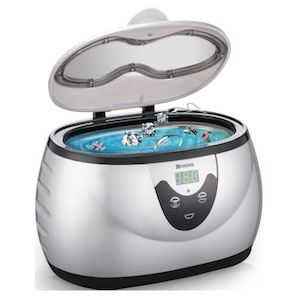
-----
Hobbyist aluminum anodizing
Quickstart:
Readers wanting a quick intro to anodizing of aluminum may wish to view our "Intro to Aluminum Anodizing (Anodic Oxidation of Aluminium)".

Aluminum How-To
"Chromating - Anodizing - Hardcoating"
by Robert Probert
Also available in Spanish
You'll love this book. Finishing.com has sold almost a thousand copies without a single return request :-)
Q. I'm interested in anodizing small quantities of aluminum wire. The item to be anodized will be approximately 16 gauge aluminum wire (probably 5356) that's been wound into a tight spring-like coil about 1/2" in diameter x approximately 12" long, and stretched slightly to allow for anodizing and dyeing between the windings.
Once colored, the coils will be sliced with a thin saw to produce rings. I have experience with the coiling and cutting but not the anodizing. Since I have small quantity requirements (a few coils at a time), I'd like to build a small home anodizer I can use as needed.
I've read several articles on the subject and believe I understand the concepts. I plan to do this outdoors. My concern is that of storing the sulfuric acid bath between uses. I've found an 18" tall x 12" diameter sealable (twist-lock lid) HDPE pail that I can line with an open cylinder of aluminum sheet to form the cathode.
The coils would be suspended from an aluminum bar across the top of the pail. Power would come from a car battery charger
⇦ on
eBay or
Amazon [affil link]
. The question is, will HDPE be suitable for long-term storage of the acid bath (in my garage)?
Glass might be better but I can't find a large enough container and I don't care to risk breakage and spilling 5 gallons of acid. And I'd rather not have to handle the acid by pouring it back and forth between storage and working containers anymore than necessary (spillage concerns).
If I rinse the anodized coils in a baking soda [in bulk on eBay or Amazon [affil link] solution then in distilled water, should I be concerned with disposal of the rinse water?
Is there anything that makes this an unsound project?
Am I under-estimating the complexity?
Barring my own anodizer, am I likely to find a professional to anodize a coil or two of wire and can I wait a few hours or days between anodizing and coloring while they are returned to me?
Sorry to be so long-winded. I wanted you to understand what I'm trying to do here. Thanks for any suggestions or guidance you can give.
Ray WestonHobbyist - House Springs, Missouri, USA
2003
A. The HDPE will work for storing the acid. I'm not sure about the twistlock lid type but I would get an air tight one to avoid evaporation. Fill it with water and lay it on its side to see if it leaks..if it doesn't good enough. The easiest way would be to just use a kit like provided by suppliers serving the hobby plating market. Make sure the battery charger ⇦ on eBay or Amazon [affil link] is a manual one because the automatic ones won't work. Make sure you use a good degreaser before anodizing. I wouldn't even use a room temp sealer, I've had good luck with nickel acetate steam sealing. Make sure you hook up good ventilation! I built boxes around my tanks and a blower fan sucking any fumes out. If you have any questions feel free to ask..about 6 months ago I put together a small anodizer for doing almost exactly the same thing you are doing.
Good luck,
Jason Aube- Flint, Michigan
Ed. update: The only thing thing that has changed a lot since 2003 is that regulated, adjustable power supplies are no longer the province of only professional laboratories -- these days a proper power supply doesn't cost much more than a far less suitable automobile battery charger.
Q. Thanks for the info, Jason. Sounds like the HDPE is just what I need. McMaster-Carr sells what I described. I don't have one yet, so I can't confirm how well it seals.
I'd considered the kits, but as I recall, they come with tanks which might be good for use, but didn't seem too well suited for long term storage. Besides, I rather enjoy designing and building things like this as much as using them.
As for ventilation, I plan to set this up in the driveway when I use it, so I should have plenty of fresh air.
I hadn't given a lot of thought to sealer, but the plan was to dye the anodized coil in RIT dye ⇦ on eBay or Rit Dye [affil link] at room temp or slightly higher then boil it to seal the pores. I've used Rit at room temp to dye nylon, and at double-strength it works well for that. Not sure about aluminum, though.
Degreaser is another area I'm not yet sure about. The wire will be brand new welding wire (5356 aluminum) but will still likely have some manufacturing oil on the surface. If necessary, I had planned to dip the coils in something like Simple Green ⇦ on eBay or Amazon [affil link] and rinse before anodizing. If more agitation or handling (scrubbing) is required, I'll need to do that before coiling but then I'll risk getting skin oils on the wire when it's coiled. Any thoughts on that?
Speaking of rinse water, how unwise is it to dump the dilute acid-rinse bath afterwards? How do you dispose of yours? Is evaporation acceptable?
Ray Weston [returning]Hobbyist - House Springs, Missouri
A. Some people get anodizing that is good enough for their purpose from a battery charger. Anodizing is normally done at a slightly higher voltage. Most anodizers will ramp up their voltage rather than ON/OFF. You have mentioned nothing about controlling temperature of the acid solution. It makes a huge difference. Your application might be small enough vs the quantity of liquid that you might have an acceptable temperature rise. But, what if you want to make 10 runs that day. On dumping rinses, why should 1000 hobby anodizers be allowed to dump 1-10 gals of rinse water a month and a commercial anodizer is not allowed to dump 1 pint? Next, working in your driveway is a terrible idea in my very biased opinion. I doubt if you can be near your proposed rig constantly. Risk is a pet or the neighbor's kid getting into your acid. Most city ordinances prohibit this and many neighborhood covenants also prohibit. If I were your neighbors, I would bitch to anyone that would listen.
You are trying to learn, but there are a massive amount of rules that you have to comply with. Like most eager people, you will probably charge forward with inadequate preparation.
James Watts- Navarre, Florida
Q. James,
My needs are such that I plan to do maybe two runs at a time. That should give me enough material (about 4,000 cut rings) to keep me busy for a couple of weeks. At most, I'll be doing 4 batches per month, 2 at a time. I could have a few gallons of rinse water to dispose of a couple of times a month. I live in a semi-rural area. My nearest neighbor is a couple of hundred feet away, through the woods. I doubt that anyone would even notice. It's legal for my neighbors to practice their rifle skills in the front yard, so I doubt that anyone is going to make a big stink about a guy anodizing some wire. Still, I'd like to do this the right way. So if dumping the dilute acid water on the ground isn't acceptable, how does one get rid of the rinse water properly? Are there disposal companies that will take a five gallon jug of it? As for being near the setup, if it takes a couple of hours to do, I do plan to stay with it. Just as I do when I roll my radial arm saw out to the driveway to cut lumber. Respectfully, I don't see how doing it in the open is any worse than doing it in my garage and venting concentrated fumes out a single pipe.
Cooling? *IF* that becomes a problem, I'd considered a set that uses a coil of aluminum tubing inside the tank to form the cathode. Through that, I can circulate cold water that runs through a tub filled with ice. That ought to lower the temperature adequately *IF* it becomes an issue.
As I said originally, this is a concept. If I could find someone to anodize my coils (10 or 20 of them at a time) and if I could get them back to the dye solution before they oxidize, I'm open to that as well.
Ray Weston [returning]Hobbyist - House Springs, Missouri
A. Hi Ray! Yes, neighbors practicing their shooting skills can certainly be far more dangerous than anodizing! ... and carelessness with a radial arm saw poses far more danger than carelessness with anodizing rinsewater. You're right! Those things are also more dangerous than a short drive without your seat belt -- but explain it to the cop who writes you a ticket.
Former NJ governor Tom Kean famously clarified it this way: "Toxic is a matter of statute, not opinion". Plating & anodizing were the nation's very first EPA regulated businesses, going back to 1974. US law prohibits buinesses from selling plating/anodizing services, or plating/anodizing items that will be sold, without environmental permits and scrutiny.
There is no exception in 40 CFR 433 for small size -- but please see if there is a different category for jewellers. Clearly the justice department isn't hot on the trail of people with a bucket-full of anodizing solution in their driveway; but if something goes wrong and someone hassles you, for example a dog or child gets into it, it's no fun to have to say "Yes, I knew it was illegal, but..." 🙂
Best of luck.

Ted Mooney, P.E.
Striving to live Aloha
finishing.com - Pine Beach, New Jersey
Ted is available for instant help
or longer-term assistance.
Thanks, Ted. I'm really not meaning to be argumentative. The rings are used in making costume pieces. It started out as chainmail, then grew to jewelry and other costume items. I intend to consume all of the rings myself and I've never sold any of the items I've made. That's not to say that if offered $20.00 for chain bracelet I'd refuse, but it hasn't come up so far. I've given things away, but never sold any. I've been working with stainless, aluminum, bronze, etc. and would like to add some color. Hence the anodizing. With no intention of mass-producing or selling rings or things made from the rings, I thought it would be an interesting experience to build a small-scale anodizer for occasional use. I think I know how to do it, but I was hoping for some clarification. Yes, I could order the rings, but each time I need a few hundred red (or blue, or green, etc.) rings of a particular gauge and diameter, I may wait several weeks and pay a significant premium. Or, I could fire up the anodizer and color what I need when I need it. I appreciate James' comments about not dumping rinse water. I have no intention of actually dumping the water. I have a well and a septic system and do not wish to contaminate or damage either. So my question remains what is the appropriate way to dispose of rinse water, be it 1 or 1,000 gallons?
Ray Weston [returning]Hobbyist - House Springs, Missouri, USA
A. There is no good way for a hobbyist to get rid of rinse water. One approach would be to combine your rinses and then neutralize with baking soda [in bulk on eBay or Amazon [affil link] to a pH of 5-9 or as close to 7 as you can get. You can get short range indicator paper ⇦ on eBay or Amazon [affil link] from a number of sources. You should not use litmus paper for this. build a screen cage, put a small heater in it with a large pyrex bowl. fill the bowl and use the lowest heat possible. Evaporation will be very slow, but it will meet your needs and be safe. Trust me on the lowest heat bit or it will bite you later. Periodically scrape the material into a plastic widemouth bottle that you label as a satellite accumulation container with anodize waste. You can legally keep this for a very long time. When it gets full, transfer the contents to a larger plastic container. See if you can get a Mr. Yuk label for it. Do not use a skull & crossbones. It means something else legally, and it is an attractive hazard for kids. Mr. Yuk, they understand is not to be messed with. This will get you very very close to legal.
James Watts- Navarre, Florida
A. I use RIT ⇦ on eBay or Rit Dye [affil link] too. I have noticed that the quality of the color varies quite a bit with Rit. Sometimes the colors turn out perfect and sometimes they are splotchy (this isn't a slam on Rit company, their dye works great for its intended purpose) I've been told the pH in dye is essential. That may be the problem with Rit. I haven't had any troubles with regular anodize dye yet. So I would suggest buying at least 1 regular dye..if it works well in that and not in rit..you will know your problem. experiment with dye temperatures, this plays a huge roll in the color. If I dip a ring in room temp red dye, I'm lucky to get it light pink...heat it to about 140 and its beautiful red. You can buy electric grill things at Walmart that work great for $10.
For sealing I've noticed more of the color leaches out in boiling. It seems to retain its color better steaming. Getting the aluminum clean is essential...I use an ultrasonic jewelry cleaner with Alconox ⇨
for my rings...it works well...you can also heat up the Alconox and soak the aluminum for awhile (the longer you soak the more shine you lose).
As for rinse water, I take the easy way out. I know someone that has to dispose toxic liquids, we trade services. I give him my water, he takes care of it, I make him stuff. Since I have a small setup I'm not too worried about it(as long as its not damaging environment) but I want to expand in it so I'll be checking out the legalities/procedures.
P.S.: if we hadn't already mentioned this...mix dyes/acids/cleaners in distilled water.
Good luck,
Jason Aube- Flint, Michigan
A. A common-sense approach to what you're dumping into a stream is in order. First, you're probably using sodium hydroxide for etching (commonly: lye) which quickly breaks down into salt and water when introduced into ground water or soil. Next, you're anodizing with battery acid
⇦ on
eBay
or
Amazon [affil link]
, another relatively 'natural' substance - sulfuric acid. This also breaks down very soon after introduction into nature into harmless chemicals. Finishing your anodization is nickel acetate, which may actually harm the environment - if you dump it out, which you will not need to do for hundreds, or maybe thousands, of anodization runs if you keep it free of contaminants. But it's still not a fraction as environmentally offensive as the chemicals used in industrial chrome plating - which is what all the strict regulations on plating waste is intended to control. So use some common sense and realize your impact - which, for home anodization, is very, very small.
Thanks.
- Portland, Oregon, USA
February 3, 2008
Q. Hello there.
I am currently doing some home anodizing and things are going quite well. In a 40 cup glass canister I mixed 34% sulfuric acid 3:1 with water (10 cc acid to 30 cc water). I'm using an Astron VS-35 power supply. I use a 4x4x2 stripped aluminum heat sink as my cathode fed by a screwed-in heavy gauge aluminum wire. My parts are hooked up to Ti wire (contact is quite good). I notice with small parts the volts climb up to 15 and when the supply hits 15 the current drops from where I set it to wherever it ends up (sub 1.5 A). I let this go for 1 to 1-1/2 hours and get quite nice results. Not sure if this is CV or CC [ed note: it's voltage-limited constant current 🙂 ], I don't see how you'd force this supply to be one or the other. I just turn the volts to max (15) and turn the amps to what my 720 rule suggests as the voltage is rising.
If I wanted a bit more amps per square foot, would a bit more acid lower the resistance of the bath allowing the amperage to come up a bit. I'm not very mathletic, but how is the concentration as mixed?
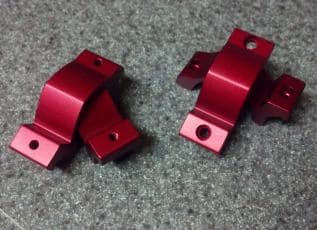
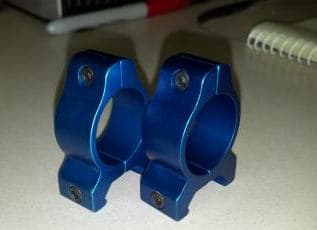
Hobbyist - Torrington, Connecticut, USA
October 22, 2012
A. Anodizing at a constant 15 volts and letting the current fall as it will is a perfectly acceptable method. You should be able to get good results with your present formulation. You should also have temperature control of your solution. 50 °F would be nice, 60 °F acceptable. Above that, the anodize coating tends to redissolve, resulting in longer times to adequate thickness.

Jeffrey Holmes, CEF
Spartanburg, South Carolina
Q. I have a power supply, snagged some aluminum wire from a renovation project using the big stranded 600 V wire, and Lye for the etching solution.
I do have a question about the acid though. Just about everything refers to using Napa battery acid for the Sulfuric acid. My local hardware store sells drain cleaner that is 93% sulfuric acid according to the manufacturer (MSDS sheet). They are close and a 1 quart bottle is just over half the price of Napa acid.
My parts are small... 4 inches long, 1.15" OD and a .800" through hole. I'm thinking a one gallon solution is going to be sufficient. Am I right in thinking that 1 cup of acid and five cups of water would be about a 18.5% solution? 93 / 5?
I can then double, triple, etc to make the proper amount.
Am I close on this part?
Thanks!
Hobbyist, specialty parts manufacturer - Niles, Ohio, USA
November 20, 2012
A. Hi Ryan.
If you have 93% by weight acid, i.e., you have 93 parts of acid, but you want 15% by weight acid, you want the 93 parts to be 15% of the total parts, so you'll want 93/0.15 = 620 total parts, or 620-93 = 527 parts of water, of which you already had 7, so you'll need 520 more. So use 520/100 or 5.2X as much water as acid. Remember to do as you oughter, add acid to water -- never add water to concentrated acid.
Luck & Regards,

Ted Mooney, P.E.
Striving to live Aloha
finishing.com - Pine Beach, New Jersey
Ted is available for instant help
or longer-term assistance.
Q. Dear sir,
I am a hobbyist doing small type 2 sulfuric acid anodising. I notice that if I do not use the anodising tank for say a day or two crystals form not only on the terminals to which the lead lining is attached but also on lead joints. Does it indicate something? What is it? What should be done to prevent it?
Hobbyist - Raipur, India
December 19, 2012
A. Regarding the drain cleaner being used in place of the battery acid:
Read the ingredients on the bottle, drain cleaner is going to have things in addition to acid in it. While battery acid, is just battery acid.
Save yourself some grief and stick with the known stuff and avoid possibly contaminating your setup.
Regarding the crystal growth:
Sounds like you have a high saturation of a dissolved mineral or metal in your solution. I have no idea what, but provided the bath is operating per normal still, you should be fine.
- Boone, North Carolina
Q, A, or Comment on THIS thread -or- Start a NEW Thread
